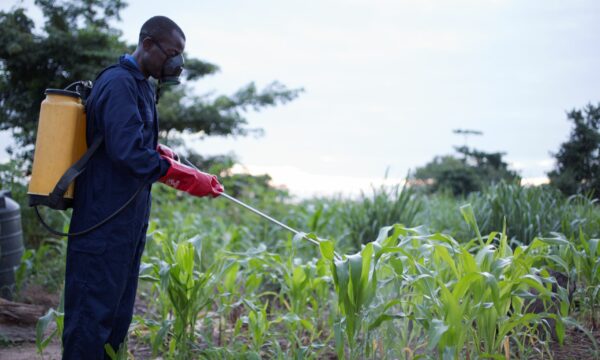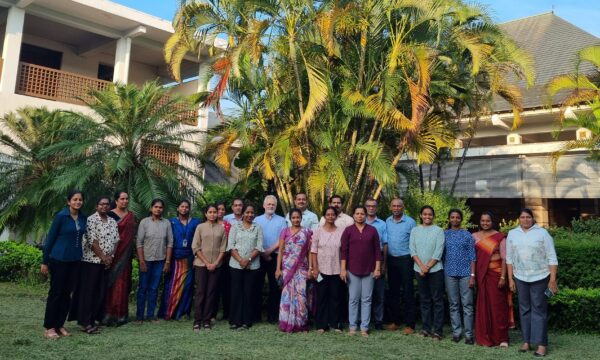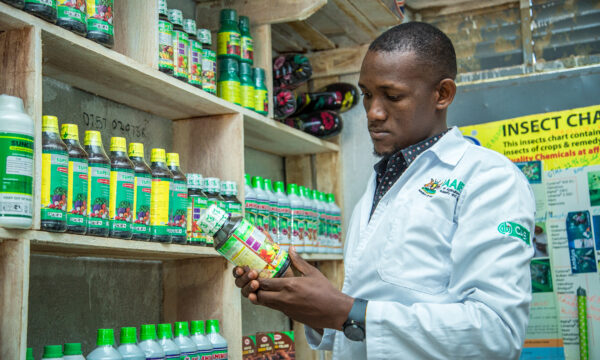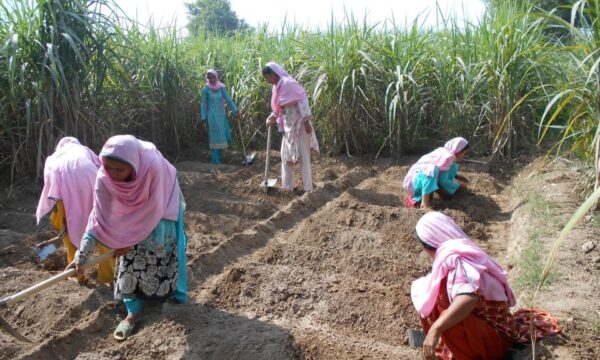Papaya mealybug (Paracoccus marginatus) is a devastating papaya pest. It impacts many countries in East and West Africa. Infestations can result in significant economic losses, posing a threat to the livelihoods of smallholder farmers. On average, the pest can cause anywhere from 53% to 100% crop losses, costing £2,224 per hectare annually. Its impact on farmer livelihoods is severe, especially when chemical pesticides stop having an effect. In some cases, the pest has prompted smallholders to abandon papaya farming altogether.
Originating from Central America, papaya mealybug has gradually spread across Africa over the past 14 years. It was first detected in Ghana in 2010 and Mombasa County, Kenya, in 2016. CABI researchers have now found the pest in over half of Kenya. Today, it poses a severe threat to all 10 of the major papaya-growing counties in Kenya. This includes the coastal counties of Kilifi, Kwale and Mombasa, as well as the inland counties of Baringo, Busia, Kitui, Meru and Murang’a. Here, papaya (known also as pawpaw) is grown for local and export markets and is important for the economy.
But science is helping farmers slow down the spread of papaya mealybug. Research has made an exciting discovery: Parasitic wasps can help control this pest.

Managing the papaya mealybug using biocontrol
Classical biological control (also called biocontrol) can successfully manage the spread of papaya mealybug. Classical biocontrol is the introduction of a natural enemy of exotic origin to control a pest, usually also exotic, aiming at permanent control of the pest. Biocontrol is the use of living organisms such as insects, mites or fungal pathogens to control pest populations. A CABI-led study has revealed the remarkable effectiveness of a tiny wasp (Acerophagus papayae) for controlling papaya mealybug. These parasitic wasps – natural enemies of papaya mealybug – feed on the pest, killing it.
Parasitism is a symbiotic relationship. One organism, the parasite, benefits at the expense of the host. The parasite relies on the host for nutrients, often causing it harm, even death. Parasitism is a way of controlling pests. In this case, parasitic wasps control papaya mealybugs by laying eggs inside them. Wasp larvae then consume the bugs. This ultimately leads to the bugs’ death, providing effective natural pest control.
Biocontrol is a beneficial approach for maintaining healthy ecosystems. This is because it reduces overreliance on chemical pesticides. Fungicides, herbicides and insecticides can harm humans and the environment.
Female wasps – playing a pivotal role in papaya mealybug control
A CABI-led paper revealed that female parasitic wasps play a pivotal role in papaya mealybug control. This is because they contribute more to host feeding or oviposition. (Male parasitoids primarily focus on mating and do not contribute directly to pest mortality.) A female-biased sex ratio is, therefore, generally more advantageous than a male-biased ratio.
Dr Selpha Miller is the study’s lead author, published in Crop Protection. She is also a Postdoctoral Research Fellow under the Invasive Species Theme at CABI. She highlighted how a female-biased sex ratio is considered positive when assessing the effectiveness of biological control agents. “When evaluating biological control agents, the sex ratio is a crucial parameter that can impact the success of a biological control programme.”

Hopefully, this new research can help further improve papaya biocontrol in Kenya and elsewhere in the East Africa region where the pest is prevalent. PlantwisePlus has been working to halt the spread of this devastating pest since 2021, focusing most recently on Kenya’s coastal region.
PlantwisePlus – building partnerships to manage papaya mealybug populations
CABI has been working on the biocontrol of papaya mealybug in East Africa for several years. Partners include KALRO, KEPHIS, NARO-Uganda, the University of Juba, and the National Museums of Kenya. The researchers identified Acerophagus papayae as a promising solution for curbing the papaya mealybug problem in East Africa (Kenya, South Sudan, and Uganda).
In Kenya, the team has introduced the parasitic wasp along the Kenyan coastline. Papaya mealybug has heavily affected this region. Six pesticide-free farms were chosen for wasp release. By ensuring farmers had not used pesticides on their farms, the researchers could ensure that chemicals would not harm the beneficial wasps.

From January to March 2022, the wasp population was boosted from 500 to 18,185 per week, a testament to an effective mass-rearing system. A CABI expert in mass rearing of the wasps, who is based in Pakistan, trained technical personnel in Kenya – a great example of effective south-south cooperation. Following stakeholder public consultation and awareness raising, the wasps were released in coastal Kenya and swiftly established themselves at release sites, reducing the papaya mealybug counts significantly.
The future of papaya mealybug control
The recent discovery around female parasitic wasps will help CABI scale out this strategy in other parts of Kenya and East Africa. The study underscores the wasp’s remarkable efficiency in managing the papaya mealybug population. It offers a promising ecological solution for the coastal and inland counties of Kenya and hope for its farmers. The project has not only demonstrated successful collaboration. It has also highlighted the potential for sustainable pest management practices that protect crops, biodiversity and farmer incomes.
Read the paper in full: Selpha Opisa, et al. (2024) Prospects of classical biological control of papaya mealybug in Kenya: Performance of its exotic parasitoid, Acerophagus papayae, under laboratory and field conditions, Crop Protection, 175, DOI: 10.1016/j.cropro.2023.106476.
Learn more about PlantwisePlus here.
Learn more about our work in Kenya here.
PlantwisePlus gratefully acknowledges the financial support of the Directorate-General for International Cooperation (DGIS), Netherlands; European Commission Directorate General for International Partnerships (INTPA, EU); the Foreign, Commonwealth & Development Office (FCDO), United Kingdom; and the Swiss Agency for Development and Cooperation (SDC).
1 Comment
Leave a Reply
Related News & Blogs
How do pest risk registers address the spread of plant pests in Africa?
Pest risk registers can help to solve problems in agriculture, addressing the growing global threat of plant pests. Moreover, changing weather patterns, led by rising temperatures, are causing them to reproduce faster and expand into new regions. In ad…
10 July 2025





Great information on papaya mealybug